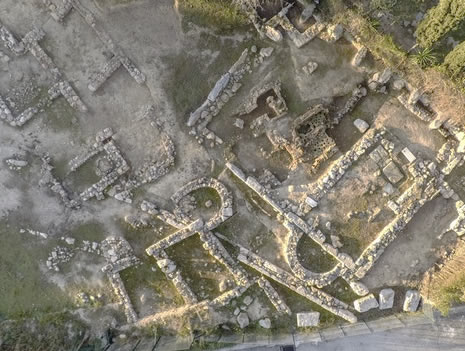St Nicholas of Pallon

The site at Aghios Nikolaos Pallon originally belonged to the former Organization for the Administration of Ecclesiastical Property. In 1934, it was granted to the Greek Archaeological Service, due to the existence of ancient remains that were visible on the surface.
The site remained unexplored until 2008, when, following the initiative of the Ephorate of Antiquities of Piraeus, small-scale research was carried out for two seasons (2008- 2009). The results were encouraging for the continuation of the research project, which was finally classified as a systematic excavation, given the permission of the Central Archaeological Board in 2011. Since then, it is conducted uninterruptedly under the direction of the archaeologist E. Ligouri-Tolia, with the collaboration of the archaeologists of the Greek Archaeological Service, A.-M. Anagnostopoulou and M. Giamalidi, alongside with a team of scientific associates.
The archaeological site covers a large area (3998 sq.m.), which falls within the geographical boundaries of the ancient deme of Aixonides Halai. Ongoing research testifies the site’s use in the Classical, Roman and Byzantine times.
The earliest remains on the site include a burial enclosure and an ancient road dating to the 4th c.BC. During the Roman/Late Roman period operated a ceramic workshop comprising three kilns, two of which located within the burial enclosure. A spacious building complex comprising of at least 20 rooms functioned in close proximity to the workshop. The rooms are organized in three units, which develop around a central open-air area. The spatial organization testifies to the existence of potters’ quarters. According to the finds, the building complex was in use until late antiquity.
During the Byzantine period, two small churches were erected on top of the Classical enclosure and the Roman workshop (Church 1 and Church 2). Both belong to the type of single-aisle basilica. The site’s name, “Aghios Nikolaos”, delivered by oral traditions, might be owed to the existence of these churches.
Various ancient marble elements have been reused during their construction. Church 1 has reused the foundations of the north and east walls of the classical enclosure as its own north and east walls. Inside the church, a sarcophagus was found which contained the burials of at least 14 people, adults and children. The sarcophagus was originally part of the burial ground, however, its cover slab was re-used as part of the church’s floor.
The site of Aghios Nikolaos Pallon presents a unique advantage, since it is an expropriated archaeological site within the dense settlement network of the modern city. The archaeological remains that date to the Classical, Roman and Byzantine times testify to the uninterrupted continuity of habitation in the area of modern Voula. Moreover, the archaeological material uncovered during the excavation is particularly important since it illuminates unknown aspects of the area’s history. At the same time, it makes the archaeological team optimistic about the future results of the research.
The excavation project has a strong educational character, for it is conducted mainly with the participation of students from the University of Athens and students from Universities of U.S.A. and Australia, through the collaboration of the International Center for Hellenic and Mediterranean Studies/College Year in Athens (DIKEMES - CYA). The educational character of the project is also highlighted by the frequent visits of schools from the Municipality of Vari-Voula-Vouliagmeni at the site. Students of all educational levels are informed about the archaeology of their area and the methods of the excavation. Furthermore, the archaeological site has been included in the yearly action of the Ministry of Culture and Sports "Green Cultural Routes".
The excavation takes place every year thanks to generous sponsorships of the A.G. Leventis Foundation and the Psycha Foundation. Of significance important is the contribution of Athanasios and Marina Martinos, not only to the excavation, but also to the conduction of architectural studies and works of conservation. The Municipality of Vari-Voula- Vouliagmeni always supports the efforts of the archaeological team. Finally, the project’s permanent collaborator and sponsorship is the DIKEMES-CYA and its chairman, Mr. A. Fylaktopoulos.
The archaeological team comprises the archaeologists Dr. A. Syrogiannis (EFAPN, responsible for the study of osteological material), K. Daifa, I. Lourentzatou, the architect G. Orestidis, the designer I. Benetou, the topographer D. Orestidis, the conservators Th. Tzamalis and E. Vamvakari, as well as the professors of DIKEMES/ CYA Dr. Y. Karavas (2014-2018), Dr. A. Papadopoulos (2017-2018) and Dr. D. Schahil (2012).
Access instructions.
- Metro: Γ2, Line 2,(red), stop at: “Elliniko station” combine with Bus: • Line: 122 - Tram line, stop at “Voula station” combine with bus: • Bus: line117 - Bus: • Orange bus: Route: Athens - Sounion
Peculiarities - Danger
Visits may be arranged with the archeology ephorate. (email: This email address is being protected from spambots. You need JavaScript enabled to view it., tel. 2104590700)